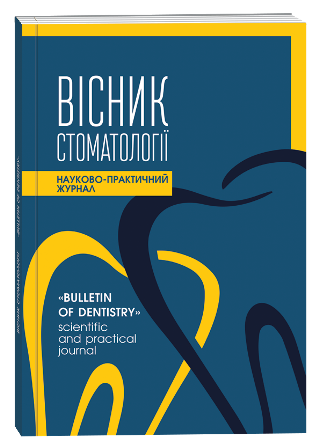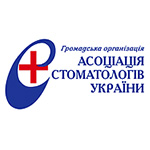MODERN STRATEGIES OF PROSTHODONTIC TREATMENT FOR TEMPOROMANDIBULAR JOINT DYSFUNCTIONS WITH PAIN SYNDROME
DOI:
https://doi.org/10.35220/2078-8916-2025-55-1.12Keywords:
temporomandibular joint, temporomandibular joint dysfunction, occlusal therapy, pain syndrome, prosthodontic appliances, temporomandibular disordersAbstract
Temporomandibular joint (TMJ) dysfunction is one of the most common pathologies in dental practice. The highprevalence of functional TMJ disorders, their significantclinical variability, and the tendency toward chronic painsyndrome highlight the need for effective diagnostic andtherapeutic approaches. Special attention should be paid to occlusal therapy as a key method of prosthodontic treatment within the multidisciplinary strategy for managing patients with TMJ dysfunction. Purpose of the study. To identify the main etiopathogenetic factors and treatment principles of temporomandibular joint dysfunctions, and to evaluatethe effectiveness of modern therapeutic approaches forthis condition. Research methods. A systematic literature search was conducted using the Web of Science, Scopus, PubMed, and Google Scholar databases for publications related to TMJ dysfunctions. The selected publicationsprimarily dated within the last 10 years, although someearlier foundational works were also considered. The relevance of publications was assessed based on the title, abstract, and full text. Scientific novelty. According tothe analysis, occlusal splints – particularly stabilization, repositioning, and disengagement splints – are effectivetools for conservative treatment of TMJ dysfunctions, especially in cases of pain syndrome. They contribute to the relaxation of masticatory muscles, reduction of intra-articular pressure, and stabilization of mandibularposition. However, their effectiveness largely depends onaccurate diagnosis and individualized appliance selection.Optimal outcomes are achieved when occlusal therapy is combined with physiotherapy, kinesiotherapy, and psycho- emotional correction. Conclusions. Occlusal therapy is an essential component of prosthodontic treatment for TMJ dysfunctions, particularly in pain-related forms. Itseffectiveness increases under a multidisciplinary approachinvolving prosthodontists, physiotherapists, neurologists, psychologists, and other specialists when necessary. Such a model enables not only the alleviation of pain but also the achievement of stable functional rehabilitation.
References
Новіков В.М., Резвіна К.Ю., Коросташова М.А., Додатко В.І., Ющенко Я.О. Дисфункція скронево- нижньощелепного суглоба. Методи діагностики та лікування. Medical Sciences modern trends of scientific development. 2022. Р. 253–257. URL: https://books. google.com.ua/books?id=UrlZEAAAQBAJ&pg=PA253.
Семчишин Я.О. Оклюзія і скронево-нижньощелепні розлади. Сучасна стоматологія. 2023. № 4. С. 44–53. URL: https://doi.org/10.33295/1992-5 76X-2023-4-44.
Яценко П.І. М’язово-суглобова компресійно-дислокаційна дисфункція скронево-нижньощелепного суглоба, особливості клінічної діагностики та лікування : дис. … докт. філос. : 221 ; 22. Полтава, 2020. 268 с.
Ohrbach R., Dworkin S.F. The evolution of TMD diagnosis: Past, present, future. J Dent Res. 2016. № 95 (10). Р. 1093–1101. doi: 10.1177/0022034516653922.
Макєєв В.Ф., Телішевська У.Д., Кулінченко Р.В. Частота та розподіл за нозологічними формами скро- нево-нижньощелепних розладів. Новини стоматоло- гії. 2009. № 2 (59). С. 48–51.
Schiffman E., Ohrbach R., Truelove E., Look J., Anderson G. et al. Diagnostic criteria for temporomandibular disorders (DC/TMD) for clinical and research applications: Recommendations of the International RDC/TMD Consortium Network and Orofacial Pain Special Interest Group. Journal of Oral and Facial Pain and Headache. 2014. № 28 (1). Р. 6–27. URL: https://doi.org/10.11607/ jop.1151.
Dworkin S.F., LeResche L. Research diagnostic criteria for temporomandibular disorders: review, criteria, examinations and specifications, critique. J Craniomandib Disord. 1992. № 6 (4). Р. 301–55.
Ожоган З.Р., Крохмаль А.В. Актуальні аспекти діагностики і прогнозування захворювань скронево-нижньощелепних суглобів. Вісник стоматології. 2024. № 2. Т. 127. С. 60–63. URL: https://doi.org/10.35220/2078-8916-2024-52-2.9.
Michalak M., Paulo M., Bożyk A., Zadrożny Ł., Wysokińska-Miszczuk J., Michalak I., Borowicz J. Incidence of abnormalities in temporomandibular joints in a population of 1 100 urban and rural patients lacking teeth and other parafunctions in 2003–2008. An international problem. Ann Agric Environ Med. 2013. № 20 (1). Р. 86–90
Schiffman E.L., Truelove E.L., Ohrbach R. et al. The research diagnostic criteria for temporomandibular disorders. I: overview and methodology for assessment of validity. J. Orofac. Pain. 2010. № 24. Р. 7–24.
Sessle B.J. Orofacial Pain. Clinical Pain Management : A Practical Guide / M.E. Lynch, K.D. Craig, P.W.H. Peng (ed.). Wiley-Blackwell, 2010. P. 161–172.
Dehghan M., Schmidt-Wilcke T., Pfleiderer B., Eickhoff S.B., Petzke F., Harris R.E., Montoya P., Burgmer M. Coordinate-based (ALE) meta-analysis of brain activation in patients with fibromyalgia. Hum Brain Mapp. 2016. № 37 (5). Р. 1749–58. doi: 10.1002/hbm.23132.
Manfredini D., Segù M., Arveda N., Lombardo L., Siciliani G., Rossi A., Guarda- Nardini L. Temporomandibular Joint Disorders in Patients with Different Facial Morphology : A Systematic Review of the Literature. J Oral Maxillofac Surg. 2016. № 74 (1). Р. 29–46. doi: 10.1016/j.joms.2015.07.006.
Бойкова К.І. Особливості діагностики та лікування дисфункції скронево-нижньощелепного суглоба. Журнал стоматологічних досліджень. 2015. № 12 (3). С. 45–50.
Орлова О.Р. Диференційна діагностика больових синдромів при патології СНЩС. Український медичний часопис. 2015. № 21 (2). С. 78–83.
Воробйов Д.В., Польщина І.А. Довгострокові результати лікування дисфункції скронево-нижньощелепного суглоба. Сучасна стоматологія. 2015. № 8 (1). С. 33–37.
Соколова І.І. Особливості клінічного перебігу дисфункції СНЩС. Сучасна стоматологія. 2014. № 2 (12). С. 33–36.
Бугровецька О.Г. Симптоматичні підходи до лікування порушень СНЩС: огляд ефективності. Український стоматологічний альманах. 2015. № 1 (18). С. 45–48.
Гасюк П.А. Об’єктивні методи оцінки функці- онального стану СНЩС. Український медичний часопис. 2015. № 21 (4). С. 56–62.
Гелетін П.М. Вплив церебральної ішемії на патологію скронево-нижньощелепного суглоба. Вісник стоматології. 2016. № 78 (1). С. 34–40.
Wadhokar O.C., Patil D.S. Current Trends in the Management of Temporomandibular Joint Dysfunction : A Review. Cureus. 2022. № 14 (9). Р. e29314. doi: 10.7759/ cureus.29314.
Прощенко А.М., Шинчуковський І.А. Порівняння ефективності використання черезшкірної електричної стимуляції нервів та мікрострумової стимуляції нервів у зменшенні клінічної симптоматики у хворих на дисфункцію скронево-нижньощелепного суглоба. Сучасна стоматологія. 2024. № 6. С. 72–76. DOI: 10.33295/1992-576X-2024-6-72.
Дрогомирецька М.С., Мірза Р.О. Клінічна нейром’язова діагностика та профілактика ускладнень при лікуванні вивиху диска скронево-нижньощелепного суглоба, який не можна вправити. Сучасна стоматологія. 2018. № 3. С. 78–85
Скрипник О.Л. Морфофункціональне обґрунтування дисфункції скронево-нижньощелепного суглоба при переломах нижньої щелепи : дис. … докт. філос. : 221 ; 22. Чернівці, 2022. 201 с. URL: https://nauka.bsmu.edu.ua/wp-content/uploads/2022/08/dysertacziya-pdf_a.pdf.
Макєєв В.Ф., Риберт Ю.О., Шибінський В.Я., Ключковська Н.Р., Кирманов О.С. Особливості оклюзійної терапії при функціональних розладах скронево-нижньощелепних суглобів. Вісник української медичної стоматологічної академії. 2020. № 20 (3). С. 249–253. DOI: 10.31718/2077-1096.20.3.249.
Al-Baghdadi M., Durham J., Araujo-Soares V., Robalino S., Errington L., Steele J. TMJ disc displacement without reduction management : A systematic review. J Dent Res. 2014. № 93 (7). Р. 37S – 51S. doi: 10.1177/0022034514528333.
Duman F., Çiçekcibaşı A., Atci N., Öztürk Keleş F. et al. Morphological changes in temporomandibular joint dysfunction and effectiveness of different treatment methods. Anatomy. 2020. № 14 (2). Р. 102–110.
Okeson J.P. The management of temporomandibular disorders and occlusion. 7th ed. St. Louis : Mosby, 2013. 487 р.
Gopi I., Muthukrishnan A., Maragathavalli G. Clinical Practice Guidelines for the Management of Tem- poromandibular Joint Disorders – A Review. Journal of Evolution of Medical and Dental Sciences. 2021. № 10. Р. 2809–2815. DOI: 10.14260/jemds/2021/573.
Боян А.М., Ніконов А.Ю., Бреславець Н.М., Герман С.І. Оклюзійні шини для лікування хворих на м’язово-суглобову дисфункцію. Основи конструювання. Харківський стоматологічний журнал. 2024. № 1 (1). С. 74–82. URL: https://doi.org/10.26565/3083-5607-2024-1-08.
Chervonna N., Proschenko A., Proschenko N. Occlusal therapy in patients with temporomandibular joint dysfunction and occlusal and articulatory disorders. Ukrainian Scientific Medical Youth Journal. 2024. № 3 (149). Р. 12–18. URL: https://doi.org/10.32345/USMYJ.1(149).2024.12-18.









